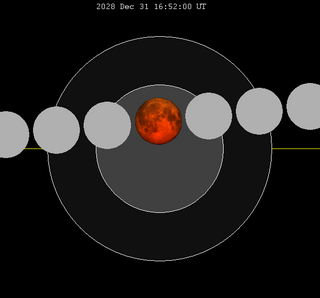The topic of this article may not meet Wikipedia's notability guideline for astronomical objects .(January 2022) |

A total lunar eclipse took place on Wednesday, December 19, 1945.
The topic of this article may not meet Wikipedia's notability guideline for astronomical objects .(January 2022) |

A total lunar eclipse took place on Wednesday, December 19, 1945.
| Descending node | Ascending node | |||||
|---|---|---|---|---|---|---|
| Saros | Date Viewing | Type Chart | Saros | Date Viewing | Type Chart | |
| 109 | 1944 Jul 06  | Penumbral | 114 | 1944 Dec 29  | Penumbral | |
| 119 | 1945 Jun 25  | Partial | 124 | 1945 Dec 19  | Total | |
| 129 | 1946 Jun 14  | Total | 134 | 1946 Dec 08  | Total | |
| 139 | 1947 Jun 03  | Partial | 144 | 1947 Nov 28  | Penumbral | |
It was part of Saros series 124.

A total lunar eclipse occurred from 5:27 to 11:06 UTC on 21 December 2010, coinciding with the date of the Winter solstice in the Northern Hemisphere and Summer solstice in the Southern Hemisphere. It was visible in its entirety as a total lunar eclipse in North and South America, Iceland, Ireland, Britain and northern Scandinavia.

A total lunar eclipse took place on Wednesday, December 9, 1992, the second of two lunar eclipses in 1992, the first was a partial lunar eclipse on Monday, June 15.

A total lunar eclipse will take place on Sunday, December 31, 2028. It will occur during a blue moon and is the first such eclipse to happen on New Year's Eve and New Year's Day since December 2009, and the first total lunar eclipse on New Year's Day in history. The next such eclipse will be on December 2047.

A partial lunar eclipse was visible on 31 December 2009. It was the last and largest of four minor lunar eclipses in 2009. This lunar eclipse is also notable, because it occurred during a blue moon. The next eclipse on New Year's Eve and blue moon will occur on 31 December 2028.

A penumbral lunar eclipse took place on November 20, 2002, the last of three lunar eclipses in 2002.

A penumbral lunar eclipse took place on 18–19 October 2013, the last of three lunar eclipses in 2013.

A total lunar eclipse will take place on November 18, 2040. The southern limb of the moon will pass through the center of the Earth's shadow.

A total lunar eclipse took place on Thursday, December 30, 1982. A shallow total eclipse saw the Moon in relative darkness for 1 hour 3 seconds. The Moon was 18% of its diameter into the Earth's umbral shadow, and should have been significantly darkened. The partial eclipse lasted for 3 hours and 16 minutes in total. This was a supermoon since perigee was on the same day. It was also a blue moon, the second full moon of December for the eastern hemisphere where the previous full moon was on December 1. Since total lunar eclipses are also known as blood moons, this combination is known as a super blue blood moon.

A penumbral lunar eclipse took place on Wednesday, January 30, 1991, the first of four lunar eclipses in 1991.

A total lunar eclipse took place on Friday, November 29, 1974, the second of two lunar eclipses in 1974.

A partial lunar eclipse occurred on the 16 and 17 July 2019. The Moon was covered 65.31% by the Earth's umbral shadow at maximum eclipse.

A penumbral lunar eclipse took place on 10 January 2020. It was the first of four penumbral lunar eclipses in 2020. The moon’s apparent diameter was larger than average because occurred only 3 days before perigee and its distance was 375,887 km.

A penumbral lunar eclipse took place on 30 November 2020. A penumbral lunar eclipse occurs at full moon when the Moon passes through Earth's penumbral shadow.
A total lunar eclipse took place on Tuesday, November 18, 1975, the second of two total lunar eclipses in 1975. A shallow total eclipse saw the Moon in relative darkness for 40 minutes and 11.1 seconds. The Moon was 6.421% of its diameter into the Earth's umbral shadow, and should have been significantly darkened. The partial eclipse lasted for 3 hours, 29 minutes and 2.1 seconds in total. Occurring only 4.9 days after apogee, the Moon's apparent diameter was 4% smaller than average.

A total lunar eclipse took place on Wednesday, October 18, 1967, the second of two total lunar eclipses in 1967, the first being on April 24, 1967.

A total lunar eclipse took place on Monday, December 30, 1963. The Moon was plunged into darkness for 1 hour and 18 minutes, in a deep total eclipse which saw the Moon 33.5% of its diameter inside the Earth's umbral shadow. The visual effect of this depends on the state of the Earth's atmosphere, but the Moon may have been stained a deep red colour. The partial eclipse lasted for 3 hours and 24 minutes in total.

A total lunar eclipse took place on Tuesday, January 19, 1954.

A total lunar eclipse will take place on August 28, 2072.

The solar eclipse of January 6, 2019 was a partial solar eclipse that was visible in East Asia and the North Pacific.

A total solar eclipse took place on Saturday, December 4, 2021, when the Moon passed between Earth and the Sun, thereby totally or partly obscuring the image of the Sun for a viewer on Earth. This eclipse was unusual as the path of the total eclipse moved from east to west across West Antarctica, while most eclipse paths move from west to east. This reversal is only possible in polar regions. Its path across Antarctica crossed near Berkner Island, traversed an arc over the continent and passed over Shepard Island.